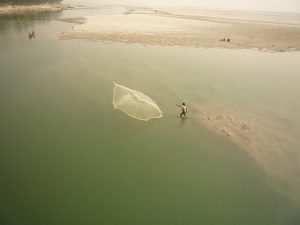China is revising its wild animal protection law, amid growing demands for a dramatic shift in emphasis. Strange as may now seem, China’s existing 1989 animal protection law was written partly to encourage sales of rare animal parts to earn foreign exchange, back in the early days of market reforms.
It has been widely criticised, and dubbed an “animal utilisation law” as it encourages captive breeding and training of wild animals, rather than conservation and protection. Chinese experts are now calling for a new emphasis on animal welfare and conservation policies, and say the new law will fail unless it discourages trading in wildlife. A draft law is due to be considered by the National People’s Congress (NPC) Standing Committee in 2015, according to the official Xinhua news agency.
Habitat destruction, hunting and trapping are the main threats to China’s wild animal populations, and critics say the existing Wild Animal Protection Law is often powerless to help.
Attitudes to animal protection are changing fast. Chang Jiwen, deputy head of the Resources and Environment Policy Institute, part of the State Council’s Development Research Centre, organised a recent seminar at which he said that only five years ago experts would not have dared to suggest including animal welfare in an updated law.
Those present were in general agreement that the ongoing destruction of China’s wildlife will be hard to stop without changing the law’s focus on how to utilise animals.
The current 1989 law created a system of wild animal breeding permits, issued by what is now called the State Forestry Administration. The belief was that the best way to protect threatened wildlife was by developing a wild animal breeding and training sector. China’s success at breeding captive pandas is the global poster child for the success in this sort of conservation. Even so, China’s panda conservationists are also increasingly turning their attention to threats to wild panda populations.
Conservationists are increasingly criticising the law’s supportive focus on breeding captive animals. Mang Ping, a professor at the Central College of Socialism, thinks the current law’s language about “appropriate use of resources” and “developing the training and breeding sector,” are a major reason wild animal numbers have fallen, saying a law based on resources use cannot control trapping and hunting effectively. “The breeding of endangered animals is just for the benefit of the rich and officials,” she says.
She pointed out that China has 6,000 tigers in captivity but only about 30 in the wild.
Breeders often catch wild animals to pass them off as captive-bred, thereby saving money and increasing their profits, according to Qin Peng of Chongqing University.
As a result, enforcement officials struggle to distinguish between wild and captive-bred turtles, resulting in falling wild populations and extinctions, according to turtle expert and deputy dean of Hainan Normal University Shi Haitao.
A report from World Animal Protection argues the current law only offers protection in order to allow for utilisation of wild animals, saying, “Only when the focus is on protection will this law be worth of its name."
During the 2013 meeting of the National People’s Congress, delegate Luo Shenglian, who is also a deputy dean of Nanchang Hangkong University, joined forces with 36 other representatives to request a revision of the animal protection law. Their proposal – which gained wide attention — urged dropping use of the phrase “wild animal resources” as it emphasises wildlife utilisation rather than protection.
Wang Song, a Chinese Academy of Sciences zoologist, helped draft the original law over 20 years ago, and says he is surprised is has still not been revised.
There are historical reasons for the emphasis on wild animals as a resource. Wang explained: “Back then we wanted to use our resources to earn foreign currency for the nation. Nearly thirty years later things are different and a change is overdue.”
Animals used as ‘resources’
Wang once told the Beijing Times that, because the country needed economic growth, wild animals were seen as resources. “Back then if we were writing about wild animals, we’d talk about how they could be used in medicine, or for their fur, or to make export products that would bring in foreign exchange.
Qing Jianhua headed the forest and wildlife protection department at the former Ministry of Forestry, and represented the ministry during drafting of the original law. In an interview with the Beijing Times, he has described how China’s understanding of wild animals has gradually evolved. In 1959 the ministry issued instructions on protection of “wild animal resources”, specifying for the same time that such resources belonged to the state, he said.
Previously wild animals were not regarded as being owned, and therefore free for the taking. Many wild animals were also seen as harmful. The People’s Daily published articles about “hero tiger-hunters” and local governments would reward anyone who killed a wolf by giving them a goat.
In the 1980s, the ministry submitted regulations on the management and protection of wild animals to the State Council for approval. However, those regulations were upgraded to the status of a law so as to give them more force. It took eight years to complete the process, but in 1989 the Wild Animal Protection Law came into force.
‘Evil industry’
Xi Zhinong, a well-known conservationist, describes the breeding of wild animals, something encouraged by the current law, as “an evil industry”. He questions whether the money China makes from the sector is worth the damage to the country’s reputation.
According to Shi Haitao, the industry is worth 7.8 billion yuan (US$1.25 billion) a year, with over 20,000 companies breeding wild animals and making products from them: “7.8 billion yuan to ruin our reputation!” he says.
When traveling abroad, Shi hears a lot of criticism Chinese for eating of wild animals, saying, “They call China a graveyard for turtle species. He says he has attended many international conferences where overseas academics attack China for hunting wild animals, rather than protecting them.
“This doesn’t just damage valuable natural resources,” said Shi. “It damages the national image.” And if this continues, he adds, China won’t have any wild animals left.








